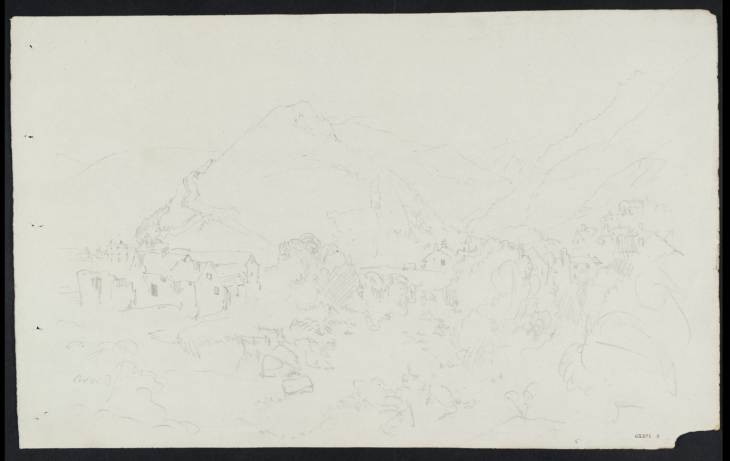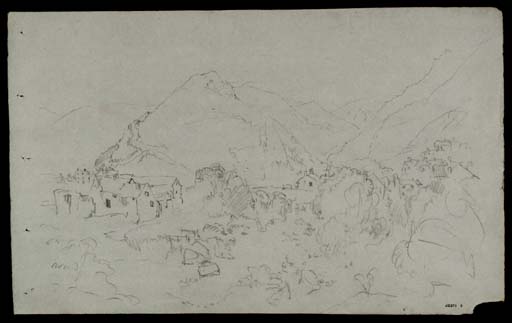Joseph Mallord William Turner Lynmouth from the River Lyn 1811
Image 1 of 2
Joseph Mallord William Turner,
Lynmouth from the River Lyn
1811
Joseph Mallord William Turner 1775–1851
Lynmouth from the River Lyn 1811
D08948
Turner Bequest CXXVI 3
Turner Bequest CXXVI 3
Pencil on white wove paper, 200 x 324 mm
Inscribed by Turner in pencil ‘[?wood]’ bottom left
Inscribed by John Ruskin in red ink ‘3’ bottom right (now faint)
Blind-stamped with Turner Bequest monogram bottom centre
Stamped in black ‘CXXVI 3’ bottom right
Inscribed by Turner in pencil ‘[?wood]’ bottom left
Inscribed by John Ruskin in red ink ‘3’ bottom right (now faint)
Blind-stamped with Turner Bequest monogram bottom centre
Stamped in black ‘CXXVI 3’ bottom right
Accepted by the nation as part of the Turner Bequest 1856
References
1909
A.J. Finberg, A Complete Inventory of the Drawings of the Turner Bequest, London 1909, vol.I, p.357, CXXVI 3, as ‘Combe Martin (?)’.
Finberg tentatively identified the subject of this drawing as Combe Martin, some miles west of Lynmouth on the Devon coast, perhaps because of the structure on the left, which may be a lime kiln like the one Turner drew there in the Devonshire Coast, No.1 sketchbook (Tate D08646; Turner Bequest CXXIII 147). There are further actual studies of Combe Martin in the present sketchbook (D08949–D08951; CXXVI 4, 5, 5a).
However, the view is clearly of Lynmouth, looking east-south-east across the River Lyn, as can be seen today from Riverside Road near the later footbridge just short of the beach. The steep coast road up the hill opposite leads to Countisbury (see D08960; CXXVI 14). To the right of the hill, now the site of a hotel, Turner looks up the valley of the East Lyn River, joined from the right by the West Lyn on the near side of the bridge, since rebuilt. The buildings on the left have gone; instead there is a high embankment at that point, with a public park beyond.
The drawing continues a little to the left to show the steep coastal hills towards Foreland Point on D40295 (the verso of D08949; CXXVI 4). Turner made another sketch looking inland from the nearby harbour on D08964 (CXXVI 18), and there is a brief continuation of it on the verso of the present sheet (D40294). There are various other views of Lynmouth and nearby Lynton in this sketchbook (D08959, D08961–D08963; CXXVI 13, 15, 16, 17), and another in the contemporary Devonshire Coast, No.1 sketchbook (Tate D08675, D08676; Turner Bequest CXXIII 164a–165).
If Turner visited the spectacularly rugged Valley of Rocks, overlooking the coast just west of Lynton, he does not appear to have drawn there. Despite the area’s picturesque and dramatic scenery, he did not produce a watercolour of Lynton or Lynmouth to be engraved for Picturesque Views on the Southern Coast (see the introduction to the 1811 tour), which instead featured an unspecific vignette of Linmouth, or Lynemouth after William Collins (Tate impressions: T05450, T05451).
Technical notes:
There are five sets of stitch holes near the left-hand edge. There is a small piece missing at the bottom right corner, matching similar losses to adjacently numbered leaves (D08946, D08947, D08949–D08951, D40295; CXXVI 1, 2, 4–5a) and to D08964 (CXXVI 18).
Matthew Imms
January 2011
How to cite
Matthew Imms, ‘Lynmouth from the River Lyn 1811 by Joseph Mallord William Turner’, catalogue entry, January 2011, in David Blayney Brown (ed.), J.M.W. Turner: Sketchbooks, Drawings and Watercolours, Tate Research Publication, December 2012, https://www


